
New York City Mayor Eric Adams has announced a plan to house as many as 2,000 asylum seekers at a tent complex on Randalls Island in the East River. Tens of thousands of asylum seekers have been sent to New York since last year and must wait 150 days to file for a work permit, leaving them no options to make a stable living. As the Adams administration claims the city has surpassed its ability to shelter new arrivals, migrants have been stuck in the city’s shelter system for months or repeatedly been forced to sleep in the streets, including last week when dozens waited outside Manhattan’s Roosevelt Hotel for days, sleeping shoulder to shoulder on the sidewalk, in hopes for a bed and shelter. We speak with Murad Awawdeh, executive director of the New York Immigration Coalition and NYIC Action, who calls for an investment in public resources and to support people as they move out of the shelter system into permanent housing. “We want to flip this on its head and actually support people to get out as quickly as possible.”
Transcript
AMY GOODMAN: We now go from El Paso to here in New York City. Mayor Eric Adams has announced a plan to house as many as 2,000 asylum seekers at a tent complex on Randalls Island in the East River, as his administration claims the city has surpassed its housing limit to shelter the tens of thousands of asylum seekers who’ve been sent to New York since last year, many by Texas Republican Governor Greg Abbott. Newly arrived migrants have repeatedly been forced to sleep in the streets, including last week, when dozens waited outside Manhattan’s Roosevelt Hotel for days, sleeping shoulder to shoulder on the sidewalk, in hopes for a bed and shelter. Others have been stuck in the city’s shelter system for months, as New York officials have failed to provide asylum seekers with permanent housing. Meanwhile, migrants who apply for asylum have to wait 150 days — five months — to file for a work permit, leaving them few options to make a stable living while they wait.
For more, we’re joined here in New York by Murad Awawdeh, executive director of the New York Immigration Coalition and NYIC Action.
Welcome back to Democracy Now!, Murad. Talk about the situation today, where the mayor, the Democratic mayor, Eric Adams, faces a deadline to tell the state, tell the New York governor, what New York City needs.
MURAD AWAWDEH: Well, first, thank you for having me with you today.
I think one piece of information I’d love to share is that New York — New York City, New York state — has welcomed immigrants and refugees for centuries. This time is no different. We have been welcoming folks from across the world. And this past year, we’ve seen an increase of folks coming from the southern border. And through that, we’ve also seen that our system is not actually working here in the city. We’re a city of 9 million people. We’re a city that has long had an incredible impact across the spectrum of contributions from various communities, specifically within immigrant communities helping build our skyscrapers, our bridges. And every piece of New York City and New York state has the immigrant imprint in it.
Last week, what we saw on the news across the globe at this point is asylum seekers sleeping outside of the Roosevelt Hotel, which has been converted into an immigrant welcome center. And those images were gut-wrenching. How can we, in the city of New York, continue to have a broken system, actually, broken shelter system, that continues to have people dehumanized in this way?
As well as last week, there was a court hearing, where the city and Legal Aid, who’s the monitor for the shelter system, went into court. And it was a closed-door session, but pretty much it sounded like, when they got out, the city needed to make its request to the state on what other supports that they needed for shelter, because in the state constitution it also puts it on the state.
But this doesn’t erase the fact that we’ve been dealing with the increase of folks coming for the past year, and we’ve just been doubling and tripling down on broken policies and broken systems that don’t work and never have worked. So, for us, we’ve been asking for people to be supported to get out of shelter and into permanent housing. And that continues to be our top ask in this moment.
AMY GOODMAN: Mayor Adams has asked to suspend a decades-old right-to-shelter order that requires New York City to provide shelter to anyone who asks for it. Talk about the significance of this, Murad.
MURAD AWAWDEH: Right to shelter is actually, as you mentioned, a decades-old policy, that actually allows for, regardless of who you are, to be able to get a shelter bed. Historically, there was a lot of tension within the services that were being provided decades ago, where single men were not allowed to get shelter. And the court found that that was inhumane and illegal. So, since then, right to shelter has been the — not just a court decree, but it’s a law.
We have numerous policies at the state level, at the local level, where we pretty much have codified, in a number of different ways — it’s a very complicated policy, but it’s incredibly strong. So you can’t just gut it because you don’t want to fix the system that’s broken. You have to actually fix it. And the best way of fixing it is actually cutting the red tape and the barriers from people who are unhoused being able to get the support that they need to get out of shelter and into permanent housing, which seems to be a big, you know, issue for this mayor, who doesn’t want to do that.
AMY GOODMAN: So, Mayor Adams is actually saying he wants to send flyers to the U.S.-Mexico border telling asylum seekers not to come to New York. And then, we know, of course, the governors are sending asylum seekers to New York. Some don’t even know exactly what’s happening or where they’re going.
MURAD AWAWDEH: Yeah. I think that we need to really invest whatever resources we have right now into staffing up our city’s workforce, and not these other stunts of, like, hiring outreach workers at the southern border to deter people from coming to New York, because New York has historically been seen as where you can achieve your American dream. And that’s why many immigrants, including my family, have come to New York, and why the city and the state’s population — over a quarter of the state’s population are immigrants. And that’s why they continue to come to the state, regardless of what folks are saying, because this is where — if you can make it in New York, you know, you can make it anywhere. And that’s the dream that folks are trying to strive for.
And in this situation, people just need a little bit of help. What we’re seeing is that adult asylum seekers and migrants who are coming here are not actually staying in the system very long. They’re staying about, on average, between 30 and 45 days. What we’re seeing that’s actually more distressing is the migrant families and recent arrival families that are actually going to be stuck in the shelter system even longer than historically unhoused families. And our historically unhoused families stay in the shelter system for years before they’re ever offered any real support to get out into permanent housing. So we want to flip this on its head and actually support people to get out as quickly as possible.
AMY GOODMAN: Murad Awawdeh, where are the asylum seekers coming from? Not all are from Latin America, but within Latin America, where? And where from elsewhere?
MURAD AWAWDEH: We’re seeing a lot of folks — I think the vast majority of people who’ve come over the past year are Venezuelan. And what we’ve seen also with regard to Venezuela is that the government has collapsed in a number of different ways, right? And we, in the U.S., are not seeing the highest migration of Venezuelans here. If you look around in surrounding countries, about 6 million or 7 million Venezuelans left Venezuela, and the vast majority of them are in South and Central America as refugees in their neighboring countries. So we’re just seeing a small population of Venezuelans coming up.
And there’s an increase in global migration across the board. So this isn’t unique to the U.S. This is happening everywhere. And we actually have to create policies that move us into being more welcoming and continuing to actually give people refuge and safety. But the vast majority of the asylum seekers are Latino, with a great deal of folks coming from Venezuela, some folks coming from Peru, Colombia, El Salvador, Nicaragua, Ecuador. But then we also have a large contingent of folks coming from Africa, right? We have folks coming from Senegal, Mali, Mauritania, Nigeria, Democratic Republic of Congo. We have folks coming from Haiti. We have folks coming from everywhere. I think —
AMY GOODMAN: Which also, by the way, goes to issues beyond immigration — for example, when it comes to Venezuela, the strangling sanctions the U.S. has imposed against the Venezuelan government.
MURAD AWAWDEH: Yeah, or just foreign policy, in general, and how our foreign policy is impacting the migration movement on a global scale, right? It’s not just what’s happening there. It’s also, historically, the U.S. interventionist policy in these other countries, as well, that has moved people to seek safety and refuge here.
AMY GOODMAN: And the climate crisis.
MURAD AWAWDEH: Absolutely.
AMY GOODMAN: So, finally, are other cities looking to New York as an example of how to deal with asylum seekers?
MURAD AWAWDEH: I think that, unfortunately, right now what we’re seeing is other cities are actually busing people to New York, as well, instead of trying to find how they can support our new arrivals, right? But if folks want to come to New York, we’re here to support them. I think that we have to — this is not just a New York issue. We’re seeing folks coming from everywhere, going to different cities.
So, I think that there is a model here that we can be uplifting. And I think L.A. actually has the better model of how to support recent arrivals and ensuring that they’re getting the support and housing, as well as the services that they need, where it’s a real partnership, from every level of government down to the community-based organizations, really stepping up to actually meet the moment together.
AMY GOODMAN: Murad Awawdeh, we want to thank you for being with us, executive director of the New York Immigration Coalition.
Next up, Iraqi men suing the U.S. military contractor CACI for torture they endured at Abu Ghraib prison in Iraq. Stay with us.

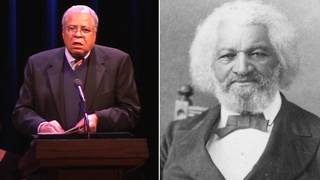
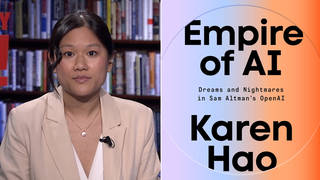
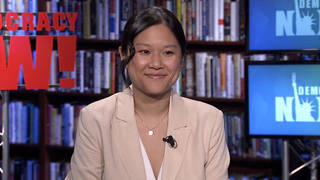

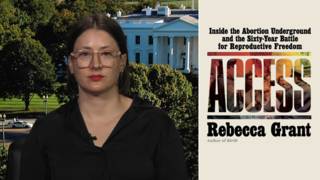
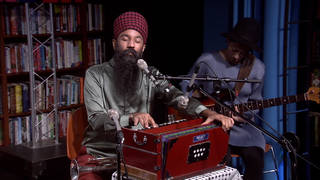
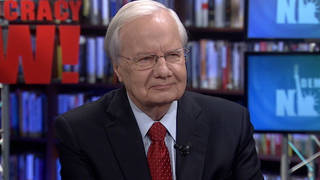
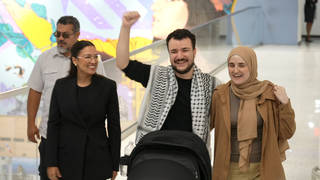

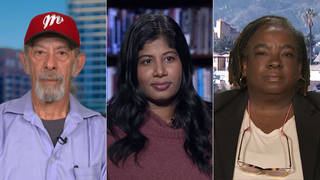

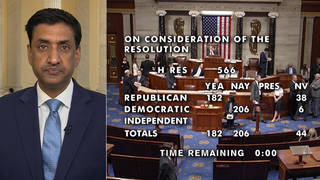
Media Options